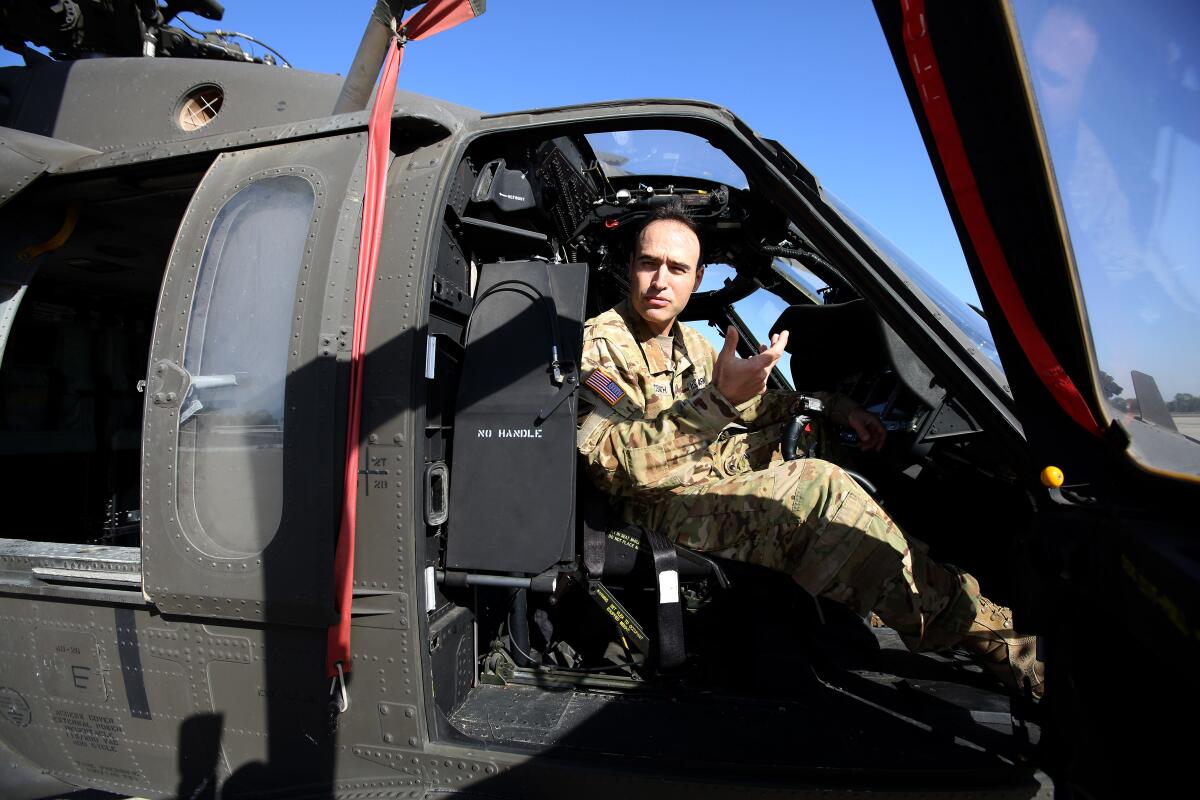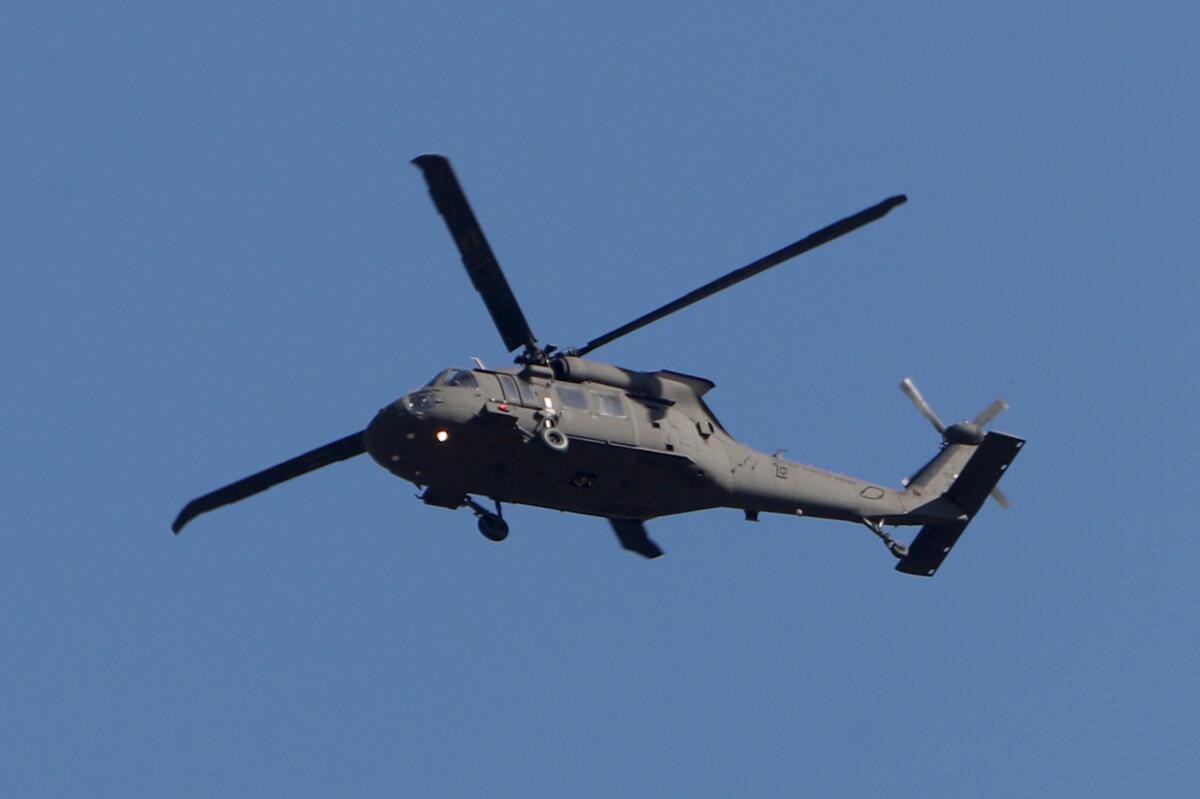After a busy wildfire season, O.C.-based National Guard helicopter battalion will deploy in 2021

As flames raced toward a Napa County home where an 82-year-old man sheltered during the Glass Fire, Lt. Col. Daniel Goldsmith of the California National Guard dropped water from his UH-60M Black Hawk onto torching trees.
Goldsmith’s crew and two other aircraft defended the home for over 30 minutes and were able to save it and the man inside. It was one major wildfire among four Goldsmith has helped fight this year.
Goldsmith and his Los Alamitos-based unit, 1st Assault Helicopter Battalion, 140th Aviation Regiment, were slated to deploy to the Middle East for up to nine months in early 2021. As of Nov. 5, the 1-140th’s deployment was scaled back from the entire battalion to about 75 soldiers. Goldsmith is among the contingent planning to stay home.
The Orange County-based aviation unit is on the frontline of a balancing act facing the California National Guard — supporting the U.S. military’s readiness to fight while assisting firefighter and law enforcement during public safety crises.
Army aviators are answering the call, but the challenge of filling these dual roles is very real amid another record-breaking wildfire season.
“The increasing demand for state emergency response is making it more challenging for the California Army National Guard to train personnel and maintain equipment for federal overseas deployment missions,” Goldsmith said.
This will be the battalion’s fourth overseas deployment since Sept. 11, 2001, Goldsmith said. As the commanding officer of the 1-140th, he’s responsible for the fleet of 18 UH-60M Black Hawks and more than 400 soldiers based at Los Alamitos Army Air Field.
Aviators with the battalion had conducted 709 flight hours on California wildfires by late October, which is more than any year in the last 20 years with the exception of 2017. And with dry, windy months still ahead, that record could be broken, Goldsmith said.

Wildfires aren’t the only incidents that have seen help from the Los Alamitos-based helicopter battalion.
In June, the California National Guard activated 8,000 service members in response to civil unrest prompted by the death of George Floyd in Minneapolis. Flight crews with 1-140th moved soldiers from Joint Forces Training Base Los Alamitos to the Los Angeles Police Department heliport in Downtown Los Angeles and flew a reconnaissance flight over Los Angeles County for the Commanding General.
In October, one of the battalion’s flight crews practiced dropping super-sized sandbags during a simulated breach at the Whittier Narrows Dam in coordination with the U.S. Army Corps of Engineers.
Amid a global pandemic, the battalion has also performed the required training to deploy and fight abroad when called upon by the U.S. Department of Defense.
“We’re prepared to go and do this mission and if something changes with that, it does. People just have to adjust. Their employers have to adjust,” Goldsmith said.
As the Global War on Terror has dragged on and the Pentagon pivots for potential conflicts with China or Russia, the National Guard has played a larger role in missions historically conducted by the U.S. Army. This means Guard units are deploying thousands of miles away from their home states more frequently.
Meanwhile, the National Guard Bureau reports the number of natural disasters requiring assistance from soldiers and airmen has trended upward nationally in recent years. In Fiscal Year 2013, the Guard responded to nearly 60 natural disasters across the country. The Guard responded to 71 natural disasters in Fiscal Year 2018.
California has seen more than 4 million acres burn this year, the most since Cal Fire started record keeping. At the summer fires’ peak, the California Governor’s Office of Emergency Services requested 16 helicopters from military officials, Goldsmith said. At any time, 1-140th can typically dispatch no more than three aircraft. This shortage of California-based flight crews required National Guard helicopters to fly from as far away as Wisconsin, Illinois, Wyoming and West Virginia.
It’s not necessarily a shortage of aircraft, Goldsmith said, but the limited number of pilots who meet a U.S. Forest Service requirement for each crew to include a senior pilot with at least 500 flight hours on their assigned helicopter. It typically takes five years for a junior National Guard helicopter pilot to hit this threshold.
Lacy Lew Nguyen Wright follows in the footsteps of her activist grandmother, Jackie Bong-Wright, and has helped inspire her mother, Annie Wright, to go into politics.
Aerial firefighting is dangerous work. The airspace above a wildfire is highly controlled and trafficked by various aircraft ,and strong winds and thick smoke make for dangerous flying conditions. Helicopter pilots often push their aircraft to its limits by lifting 640-gallon water buckets at high altitudes, Goldsmith said.
Cal Fire places experienced firefighters aboard National Guard helicopters to make sure they’re operating safely and efficiently with crews on the ground and other aircraft.
“There was a guy I flew with this time who has been a firefighter for 40 years and he said this was the worst year ever,” Goldsmith said.
The Pentagon is typically the last organization to be tapped for aircraft to suppress wildfires. In September, Marine Corps and Navy helicopters responded to the Valley Fire in San Diego County because state and regional agencies were fully stretched.
“That’s not a mission they normally do and that just shows you how bad this fire season was,” Goldsmith said.
State emergency planners are confident that there will be plenty of aircraft based in California for natural disaster response while the 1-140th is deployed overseas, said Brian Ferguson, a Cal OES spokesperson.
The upcoming deployment could offer relief to part-time soldiers who were laid off from or are underemployed at civilian jobs because of the pandemic, Goldsmith said. For others, military service provides an important support network and purpose in an uncertain time.
“We have a lot of people in this unit now who were born after 9/11 and so their understanding of why we are doing stuff in certain parts of the world and why they have to be away from their family is kind of murky,” Goldsmith said. “One thing that’s not murky is saving a house from burning down. You can see that.”
Daniel Langhorne is a contributor to Times Community News.
All the latest on Orange County from Orange County.
Get our free TimesOC newsletter.
You may occasionally receive promotional content from the Daily Pilot.



